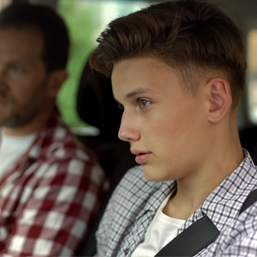
From the time they are infants, we take the necessary precautions to protect our kids, but how can we keep them safe once they start driving?
Role-model. Traffic accidents remain the leading cause of injury and death among teens but setting a positive example can help nurture an aware, focused driver. “As parents, we have a great deal of influence in how our children are going to drive by how they see us driving,” says paediatric safety specialist Brad Winfrey, BSN, RN, CPEN, CPST. “That’s why it’s so important that parents role-model driving at safe speeds, wearing seatbelts, and not driving distracted.”
Teach the MVPs of driving. After working “in the emergency department (at a children’s hospital) for 30 years, I certainly saw the impact of what teen driving, lack of experience, and distraction can do to the driver and the passengers,” says Winfrey.
Winfrey teaches young drivers the acronym MVP:
Mind - Keep your mind on driving and stay aware of what is happening around you. Pay attention to road signs, traffic lights, and construction zones.
Vision - Your eyes should be on the road ahead of you and not elsewhere in the vehicle, like texting, posting to social media, or fiddling with the radio.
Practice - Practice in a variety of weather conditions, roadways, construction areas, and especially at night, when visibility is limited, and oncoming headlights can be blinding. With evening school activities and part-time jobs, teens frequently drive at night.
Limit passengers. AAA Foundation for Traffic Safety found that a 16- or 17-year-old’s risk of death per mile rises 44 percent when carrying one passenger younger than 21 and quadruples when transporting three or more passengers under the age of 21. The potential for risk-taking behavior also increases, including not wearing seatbelts, speeding, and drinking alcohol.
Download Life 360. John Lacy, a police officer, recommends the Life 360 app to help you keep track of your teen’s whereabouts. The app also provides crash detection and emergency response and weekly driver reports, highlighting phone usage, acceleration, braking and top speeds.
“Don’t tell your children that they’re being added to Life 360; just do it,” says Lacy. “Kids are very crafty. If they know that something like that is on their phone, they’ll disable it. Remember, it’s your phone, not your kid’s cell phone.”
If you prefer to be open with your teen about the app, tell them that as a minor on the road, it provides a non-negotiable, additional layer of safety and security.
Educate them about the vehicle. Acquaint your teen with the car’s features like where the defrost is located, how to turn on windshield wipers, how to open the gas tank and how to fill it. Also, teach them how to change a tire (check the spare tire every three months to ensure it is aired up).
Under the hood, point out the battery and how to check the oil. Store a roadside emergency kit in the trunk with plastic flare reflectors (available to purchase at auto shops and online).
Know the dos and don’ts of roadside assistance. Your teen should contact you and/or the police if they are in a car accident, become stranded, or get lost. If they get lost, which isn’t uncommon for new drivers, tell them to call you first. “It’s okay to call the police if they’re lost, too,” says Lacy.
If your teen gets a flat tire, instruct them to call the police first and then you. “The reason I like an officer there is because the lights provide protection especially at night, and reminds people to slow down,” says Lacy.
Unfortunately, we don’t always know if a stranger offering help is acting as a good Samaritan or has more nefarious intentions. If your teen is stranded, they should wave on those offering help and tell them that the police will arrive shortly.
Manage a traffic stop. Explain to your teen that if they get stopped by the police, they should pull over to the right-hand side of the road, into a well-lit parking lot, or onto private property to keep them and the officer safe from oncoming traffic.
Traffic stops can be stressful, even for adults. Encourage your teen to calmly follow the officer’s instructions. Remind them to keep their hands in plain sight on the steering wheel. Your teen should know where their driver’s licence, registration, and current insurance card is located inside the vehicle. But, they shouldn’t reach for anything in the car until instructed by the officer.
“The officer will tell you the reason why he stopped you, what he’s looking for, and what he wants,” says Lacy.
After that, the officer will return to their vehicle. “Don’t get out of your vehicle!” says Lacy. “That is the last thing we want you to do. Stay inside the vehicle the entire time and let the officer contact you.”
If your teen suspects that the person pulling them over isn’t a bona fide police officer, they can call 9-1-1 with their location and confirm the traffic stop.
Many police departments record traffic stops. “Kids have a right to record the conversation, too,” says Lacy. If an officer is rude or unprofessional, parents can file a complaint with the department.
Remain patient. Your involvement and patient guidance will help your teen become a safe driver. “A lot of people immediately want to jump on the bandwagon and say that teens are bad drivers. It’s not necessarily true,” says Winfrey. “They just don’t have experience. With experience comes better driving skills and better driving habits.”
Purchasing a car for your teen?
Sources: Ofc. John Lacy; Brad Winfrey, BSN, RN, CPEN, CPST
Freelance journalist Christa is the mom of two sons. She and her husband are on the first leg of the teen driver journey with their eldest and wish all fellow parent passengers and their driving teens happy and safe travels!
Calgary’s Child Magazine © 2024 Calgary’s Child